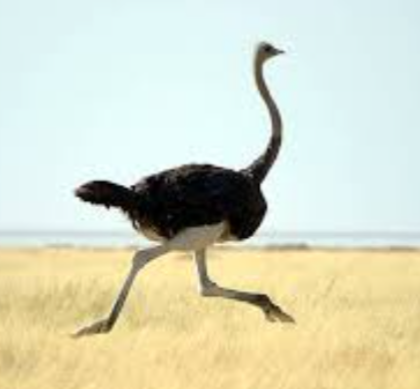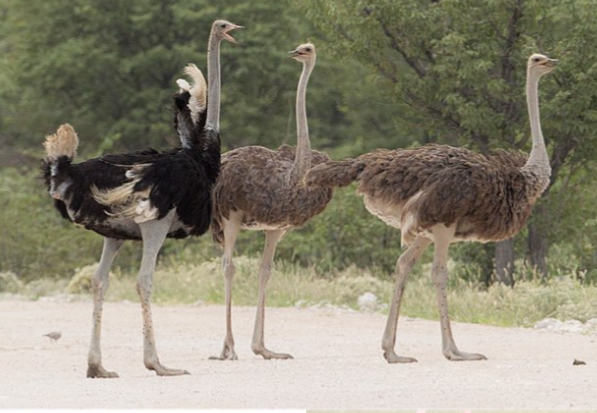
Ostriches (Struthio camelus) are large flightless birds found only in Africa. They belong to the Class : Aves (Birds), group of flightless birds called ratites, family Struthionidae, order Struthioniformes and genus Struthio. Other members in the group include kiwis, emus, cassowaries, and rheas.
The species name, ‘camelus’ was derived from camel name. The ostrich was once known as the “camel bird” because of its long neck, prominent eyes, and sweeping eyelashes, as well as its jolting walk. This characteristics of the bird initiated the species name.
WEIGTH AND SPEED : Ostrich are referred to as races of Struthio camelus.They are the heaviest and largest living birds, with adult ostriches weighing between 63.5 and 150 kilograms and laying the largest eggs of any living land animal. An adult male may be 2.75 metres (about 9 feet) tall and weigh more than 150 kg (330 pounds). They have the ability to run at 70 km/h (43.5 mph), making them the fastest birds on land. But when frightened, they can achieve a speed of 72.5 km (45 miles) per hour. Just one stride can be 10 to 16 feet (3 to 5 meters) long. The one month old chicks can run at speeds of about 35 miles per hour (56 kilometers per hour).
The ostrich’s egg, averaging about 150 mm (6 inches) in length by 125 mm (5 inches) in diameter and about 1.35 kg (3 pounds), is also the world’s largest.
DIFFERENCES BETWEEN MALE AND FEMALE:

The male is mostly black but has white plumes in the wings and tail; females are mostly brown. They possess long neck. The head and most of the neck are reddish to bluish in colour. They possess big brown eyes with thick black lashes. Their legs are strong and long with unique two-toed. The main toe developed almost as a hoof, to escape its enemies mainly humans and lions. If cornered, it can deliver dangerous kicks.
FEATHERS: Ostrich feathers are loose, soft, and smooth and do not hook together unlike in other birds. This makes ostriches look “shaggy”. They do not have uropygial or preen glands which secretes waxy oil to the plumage as found in other birds. Therefore, their feathers can get soaked in the rain because it is not waterproof. Adult male ostriches have striking black-and-white plumage; immature birds and adult females have grayish brown feathers.
Ostriches live in groups, which helps with defense. They cannot fly to escape from their enemies. They possess wings which they use to maintain balance when they run, especially when they suddenly change direction. Along with the tail feathers, both are used for displaying and courtship.
TERRITORIALITY: Ostrich shows dominance by raising its head up high and lifting its wings and tail feathers. They show submission by drooping down their head, wings, and tail feathers.
The dominant male defends the territory of about 10 to 15 flocks made up of a dominant female called the “main or alpha hen,” and other females.
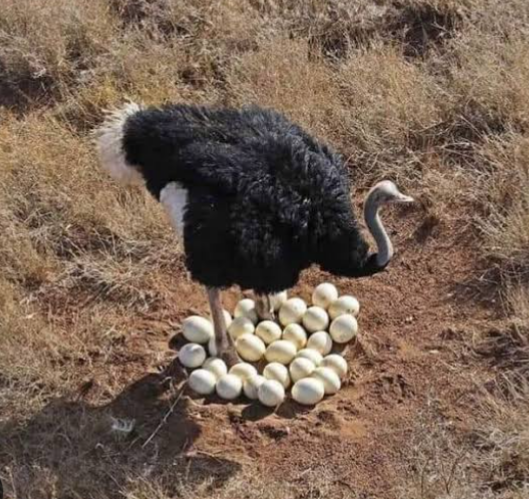
Only the alpha hen mates with the territorial male. Other females in the flock may mate with the territorial male or other wandering males that comes during breeding season. The other females in the flock do lay their eggs in the same nest with the main hen’s eggs. Such nest is called communal “dump” nest. It is the joint responsibility of the alpha hen and the territorial male to incubate the eggs. They both share the tasks of incubating the eggs and caring for the chicks. The territorial male lay on the eggs at night while the alpha hen takes the turn during the day till the eggs hatch.
An ostrich hen can lay between 7 to 10 eggs at a time. After the eggs hatch, the chicks leave the nest to travel with their parents. The adults use their wings to protect them from sun and rain. When predators are nearby, the male ostrich reacts with an alarm sound. It will also outstretched its neck and open its mouth . This it does to distract and divert the predator’s attention, so the chicks can scatter into the grass or run for cover, accompanied by the females.

PEOPLE’S MYTH ABOUT OSTRICH :People’s believe is that ostriches bury their heads in the sand. This is not true. When an ostrich senses danger and cannot run away, it flops to the ground and remains still, with its head and neck laid flat on the ground in front of it. Because the head and neck are lightly coloured, they blend in with the colour of the soil. From a distance, it just looks like the ostrich has buried its head in the sand, while the body is visible.

Enemies of ostrich include human, lion etc. Hyenas, jackals, and vultures do feed on ostrich eggs.
FEEDING: Ostriches are omnivores. They feed on vegetation, snakes, lizards, rodents and insects. They tolerate high temperatures and can go without water for long periods of time. Breeding males emit lionlike roars and hisses as they fight for a harem of three to five hens. When the female hen wants to lay eggs, nest are made in the ground. The hen can lay more than a dozen shiny, whitish eggs. Most times, the hen of the harem would get rid of some of the eggs to make incubation more manageable. Both the male and female carry out the incubation activity together. The male sits on the eggs by night while the females take turns during the day. The chicks hatch in about 40 days.
CHARACTERISTICS OF OSTRICH SPECIES
The following are summary of the characteristics of the ostrich:
1. They feed on plants and insects
2. They can live for between 50 to 70 years
3. The males and the females can be distinguished by the colour of their feathers. Males have black feathers and white feathers on their wings while females have brown feathers.
4. Ostrich start mating at 2 to 3 years of age. 5. They start egg laying between April and August
BENEFITS OF OSTRICH
1. Ostriches are raised for their meat and hide, which provides a soft, fine-grained leather. Ostrich leather are strong and durable and it is water resistant.
2. Ostriches are trained for saddle and sulky racing, but easily they become tired and are not well suited for training.
3. They do well in captivity and may live up to 50 years.
4. Their big egg is a good source of protein, saturated fatty acids, iron, vitamin and E and selenium. An ostrich egg is equivalent to 24 fowl eggs.

5. Young ostrich can be hatched from eggs and sold as source of income.
6. Lots of farmers now raise ostrich as a source of employment and livelihood
7. Some wealthy individuals keep ostrich as pets. Some use them as security pets.
8. The egg shell and bones are a good source of calcium.
9. Their meat is low in cholesterol than other meats.
10. Ostrich feathers are used as fan and hat designs by royal families in some countries. They are also used to make dusters, decoration, and fashion and costume designs.
11. Ostrich skin is used for making leather and
luxury commodities like bags, shoes, jackets and other accessories.
12. The empty shells are used for decoration or craft projects
13. Ostrich oil is used for medicinal purposes. In Tanzania, the oil is used to treat ear aches and asthma ailment and muscle spasms.
14. The oil has antioxidant properties, and they are widely used in the cosmetics and pharmaceutical industries.
15. Grease and oil obtained from wild birds like ostrich is used for massage in muscle aches and in cases of burns.
16. Unlike other domestic birds, ostrich has a breeding period between April to August. While other birds have breeding periods through out the year.
17. Eating the eggs of ostrich helps to reduce the risk of cancer and heart diseases.
18. The nutrients in ostrich eggs help to nourish the skin, nails and hair making them healthy.
BENEFITS OF OSTRICH FARMING
Ostrich farming originated from South Africa. The following are benefits of ostrich farming :
1. SUSTAINABILITY : Ostrich farming is a sustainable livestock farming. Lesser spaces are required for raising the birds. The ostrich farming helps people to meet their need in terms of food need, decoration, and valuable items needed for livelihood and revenue generation for countries.
2. PROFITABLE FARMING : Ostrich farming is a good source of valuable items like hides, feathers, bones and meat. The feathers and hides are valued in the fashion industries. A chick of ostrich can be sold to farmers and also within 6 months, the chick would have nearly reach the size of the adult ostrich. They can lay about 15 to 50 eggs per season. Younger females can lay 10 to 15 eggs while adult females can lay 40 to 50 eggs per season. By selling these eggs or hatching them and selling the chicks, the farmer will make great profit.
3. ALTERNATIVE SOURCE OF PROTEIN: Protein is needed for cells and tissue growth and development. Lots of people are looking for alternative source of protein to ruminants meat, and poultry meats and eggs. Such is the meat and eggs from ostrich farming. Many people are also interested in changing taste from animal protein which ostrich can give.
3. MULTIPLE COMMODITY PRODUCTION: Commodities from ostrich farming include meat, bones, eggs, feathers and hides. Commodities like eggs and feathers can be sourced from ostrich without harming them. These commodities can be sold to make higher profit before final slaughtering of the bird. This makes the farming a sustainable venture.
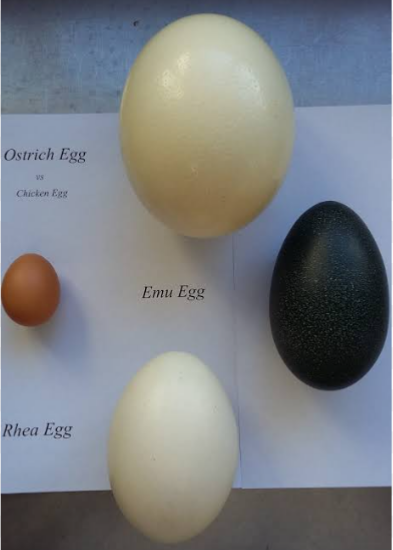
4. DROUGHT TOLERANCE: Just like camels that can go long distance without water, so is ostrich. They require water but less for survival. Most water taken are from the plants they consumed. Compared to other livestock with water being essential in their production, less water is required in ostrich farming. Other livestock cannot tolerate drought.
5. HIGH GROWTH RATE: The growth rate of chick ostrich is faster, and the reproductive rate is higher.
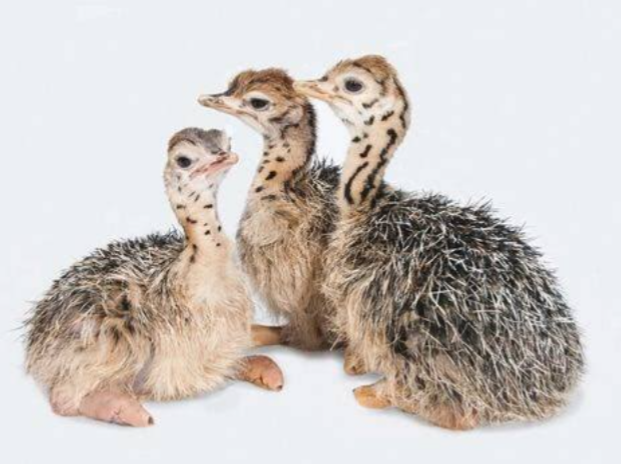
The chicks grow at a rate of 1 foot (30 centimeters) per month, and by 6 months of age they would have attain almost the size of their parents. By two years, the hen begin to lay eggs ( about 10 to 15 eggs per season) while the adult can lay up to 50 eggs per season.
6. SOURCE OF EMPLOYMENT : Ostrich is an important source of rural employment . In recent decades, there has been a growing interest in ostrich farming that provide healthy meat and valuable skins, feathers, eggs and oil. People now see the venture as being profitable and economical.
7. SELF PROTECTION: Ostrich has good eye sight and they can sight predators miles away. This will make them take to their heels. They are fast runner and they can give a blow kick that can kill a lion if cornered.
8. VALUABLE AND DIVERSE RESOUCES: Ostriches are Majorly farmed for their meat, eggs and feathers which are used for various purposes from food to cosmetics and phermacautical industries.
SPECIES OF OSTRICH
There are five species of ostrich. They include: blue necked ostrich,
Arabian ostrich,
black necked ostrich,
Masal ostrich and
Red neck ostrich.
The Arabian ostrich is now extinct. Therefore, only four species now exist.
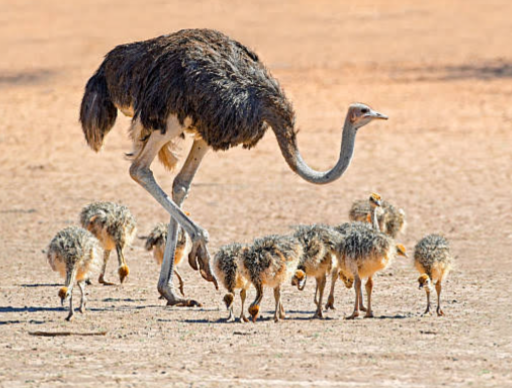
In conclusions, ostrich are quite easy to raise and manage than other livestock. Not much maintenance is required by the birds. The farming is highly lucrative as it provides products like meat, eggs, bones, feathers and lots more.
